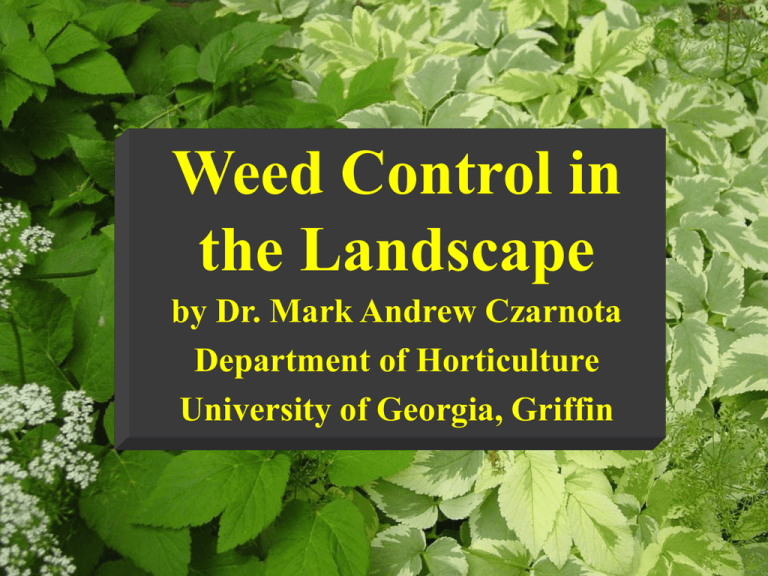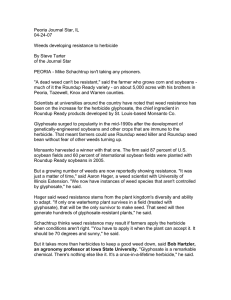Weed Control in the Landscape by Dr. Mark Andrew Czarnota Department of Horticulture
advertisement

Weed Control in the Landscape by Dr. Mark Andrew Czarnota Department of Horticulture University of Georgia, Griffin My History • Native of Pennsylvania • University of Delaware (B.S.), Virginia Tech (M.S.), Cornell (Ph.D) • Worked for 3 years between those degrees • Associate Professor and Extension Specialist at the University of Georgia, Griffin • 75% Extension, 25% Research • All aspects of weed control in ornamentals, small fruits, Christmas trees, and flower culture What is a Weed? • Plant out of place • Plants whose virtues have not been discovered • Plant that causes economic loss Chinese Privet (Ligustrum sinense) Why Control? • Plant competition • Hosts for insects and disease • Beauty Weed Life Cycles Annual: Completes growth cycle in a single growing season (Crabgrass). Perennial: A plant that persists and produces reproductive structures year after year (Bermudagrass). Biennial: A plant that normally requires two growing seasons to complete its life cycle, flowering and fruiting in its second year (Wild Carrot). Control Options • Physical Removal • Physical Barrier • Bio-control • Chemical weed control Physical Removal Hand removal or tillage: • Tillage mainly used in bed preparation • Hand removal can be useful with annual shallow rooted weeds Physical Removal Flame throwers and heat: • Flame throwers are used to remove weeds in sidewalk joints / cracks, and nonorganic mulches • Fire is used to remove brush and hardwoods from conifers • Heat is used to steam sterilize soil in greenhouse and potting mixtures Physical Barriers • A film, fabric, or layer that smoothers plant growth • Many synthetic fabrics allow air and water to pass • Use in combination with mulches • Many brands, expensive ($0.25 to $2 / ft2) • Weeds often penetrate • Synthetics can last for many years (+10) as long as not exposed to UV Physical Barriers Mulches: • Organic or Inorganic: (pine needles, bark or wood chips, river rock, marble chips, lava rock, etc.) • Organic mulches should be composted! • Maintain a 2 to 4 inch layer of Bare soil = Weed Growth mulch! • Helps maintain soil temperatures and moisture, as well as add organic matter Bio-control • Pathogens, insect, and grazing animals can be used to control weeds (Grass Carp, Goats, etc.) • Pathogens and insects are hard to develop: move to desirable plants and short shelf lives • Few marketable products available (The fungus Phytophthora palmivora was marketed for the control of strangler vine in Florida, i.e. DeVine) Bio-control • The thistle weevil has been very successful at providing long term control of thistles. • Might not see many organisms developed in the future, but might see their products or mechanisms. Chemical Weed Control •Last alternative, usually combined with other control measures •Products are safe when used properly. •They are easy to use, and save hours of labor •Two herbicides that had a huge impact on food production, 2,4-D and atrazine, simply changed the world forever. Herbicides Preemergent Apply to bare soil or mulch before germination of seeds Need water to move (activate) herbicide into seed germination zone Postemergent Apply any time after seed has germinated Need a certain period of dryness after application Pre Herbicides Activation or leaching (Via water) is required to get herbicide in weed seed germination Herbicides •Selective herbicides control a certain group of plants, but safe on others (2,4-D) •Non-selective herbicides control all plants that they come in contact with (Roundup) Herbicides Foliar applied or soil applied: • Preemergent (Preen) • Postemergent (Roundup) • Pre / Post (Image) Herbicides •Formulations are created to be applied dry (granular) or as a liquid (sprayable) •Sprayables are made with concentrates (liquid or dry) Herbicides Trade names, common chemical names, and confusion! Trade name: Roundup Active ingredient (Common chemical name): glyphosate Full chemical name: N-(phosphonomethyl)glycine Mode-of-action • All herbicides have a mode-of-action or a chemical means by which they control a plant (some have multiple). Glyphosate (i.e. Roundup) inhibits the EPSP synthase pathway and the production of tryptophane, tryrosine, and phenyalanine • Some plants have mechanisms by which they detoxify herbicides (most have multiple). Most grass plants have the ability to detoxify phenoxy (2,4-D) herbicides by performing a biochemical process called NIH shift Mode-of-Action Dinitroanilines • Include the herbicides: Trifluralin (Treflan), Pendimethalin (Pendulum), Oryzalin (Surflan), Benefin (Balan), Prodiamine (Barricade) • The colored herbicides • Only used as preemergent herbicides • Backbone of the ornamental industry • Causes microtubule disruption in plants • Used to change ploidy number in tissue culture Pre Herbicides for the Nursery Industry Trade Name Active Containers (C) / Field (F) Casoron (dichlobenil) F Y Dimension (dithiopyr) F, C Y Broadstar (flumioxazin) F, C N Gallery (isoxaben) F, C Y Pennant (metolachlor) F, C Y Devrinol (napropamide) F, C Y Surflan (oryzalin) F, C Y Ronstar (oxadiazon) F, C Y Weedfree 63 (oxyfluorfen) F,C Y Pendulum (pendimethalin) F, C Y Barricade (prodiamine) F, C Y Kerb (pronamide) F N Princep (simizine) F Y Treflan (trifluralin) F, C Y Landscape Use Post Herbicides for the Nursery Industry Grass Herbicides Non-Selective Herbicides Trade Name Reward Finale Active (diquat) (glufosinate) Trade Name Active Envoy (clethodim) Acclaim Extra (fenoxaprop) Fusilade II (fluazifop-p-buytl) Segment (aka: Vantage) (sethoxydim) Selective Broadleaf Herbicides Trade Name Active Basagran (bentazon) Roundup (glyphosate) Goal (oxyfluorfen) Lontrel (clopyralid) (pelargonic acid) Sedgehammer (aka: Manage) (halosulfuron) Image (imazaquin) Garlon (triclopyr) Scythe Combo Herbicides • Dry formulation • Contain a burndown herbicide (oxyfluorfen) and a preemergent herbicide (pendimethalin) • Easy to apply and forgiving Combination Herbicide for the Ornamental Industry Trade Name Formulation Active Containers (C) / Field (F) / Landscape (L) OH2 3 GR oxyfluorfen / pendimenthalin F, C, L Rout 3 GR oxyfluorfen / oryzalin F, C, L Kansel+ 3.25 GR oxadiazon / pendimethalin F, C, L Snapshot 2.5 GR isoxaben / trifluralin F, C, L Showcase 2.5 GR isoxaben / trifluralin / oxyfluorfen F, C, L XL (Amaze) 2 GR benefin / oryzalin F, C, L Regal O-O 3 GR oxyfluorfen / oxadiazon F, C, L RegalStar 1.2 GR oxadiazon / prodiamine F, C, L Weedfree 75 5 GR oxyfluorfen / trifluralin F, C, L Herbicide Fate Herbicide ½ Life Amount of time it takes a herbicide to reach one-half (t1/2) of the originally applied concentration. Expressed in days, wks, months, yrs. 1.0 lb. 0.5 lb. Post Herbicides – Avg. t1/2 Herbicide 2,4-D Dicamba (Vanquish) Clopyralid (Transline) Days (soil) 10 21 – 84 40 Triclopyr (Garlon) 10 – 46 Sethoxydim (Poast) 5 Glyphosate (numerous) 47 Glufosinate (Finale) 7 Organic Organic production - Several products on the market that contain burndown type chemicals: •Acetic Acid •Malic Acid •Strong Soap •Clove oil •Lemon 0il Also one preemergent product Corn Gluten Roundup Glyphosate (i.e. Roundup) inhibits the EPSP synthase pathway and the production of tryptophane, tryrosine, and phenyalanine. This pathway is not present in mammals (LD50 is safer than table salt) Roundup resistant crops (Soybeans, Corn, Canola, Cotton, and others in the future) Roundup Lots of new formulations Glyphosate is off patent 0.25 to 10% Concentration – using 41% active (25 to 50% if wicking, 50 to 100% if treating stumps) Roundup Glyphosate damage in ornamentals (sub lethal doses) Adjuvant Spray additives used to enhance herbicide performance and include: Surfactants Crop Oils Antifoaming Agents Drift Control Agents Adjuvant Enhancement of Herbicide Activity: Surfactants (X-77, Kinetic): Added when mixing herbicides, but included in many formulations. Crop Oils (MSO, COC): Added when mixing grass herbicides (Select, Fusilade II). Woody Weed Control • Trees, Shrubs, and Vines can be controlled with stump applications. • Roundup and Garlon can be used at 50% or full strength, and painted to fresh cut stems or stumps. • In unmanaged areas, you can do a basal bark application with Garlon and other herbicides. Cut Paint The nasty weeds! Difficult Weeds Yellow nutsedge (Cyperus esculentus) Purple nutsedge (Cyperus rotundus) Weeds Hairy bittercress (Cardamine hirsuta) Weeds Creeping Woodsorrel (Oxalis corniculata) Weeds Spurge (Euphorbia sp.) Weeds Phyllanthus spp. Weeds Mulberry weed (Fatoua villosa sp.) Florida Betony Florida Betony (Stachys floridana) Weeds Selective Control: Envoy (clethodim) Fusilade (fluazifop-p-buytl) Vantage (sethoxydim) Non-Selective Control: Roundup (glyphosate >5% solution using 41% to make that 5%) Bermudagrass (Cynodon dactylon) English Ivy Hedera helix Bamboo Planted for ornamental uses and escaped – most Phyllostachy spp. Growth characteristics makes bamboo difficult to control Phyllostachys spp. Results 2004 Control of bamboo (Phyllostachys rubromarginata) with selected herbicides. Bamboo Control Treatment Rate 8 WAT 16 WAT kg ai/ha ---------- % 0b 0b 0c 0c Untreated 25 WAT 61 WAT ------------ ------------ Dichlobenil 17.9 23 b 23 b 0c 7c Glyphosate 4.5 88 a 88 a 82 b 47 b Imazapyr 1.7 87 a 87 a 95 a 88 a 25 25 3 15 LSD (0.05) Results Imazapyr 1.7 kg ai/ha Glyphosate 4.5 kg ai/ha Safety • Know the plants you are trying to control • Read the herbicide label • Calibrate your equipment • Wear appropriate safety equipment • Common sense Plant Books • Manual of Vascular Flora of the Carolinas, by Radford, Ahles, and Bell (Publisher: The University of North Carolina Press) • Flora of North America (Publisher: Oxford Press) Weed Books • Weeds of the NorthEast, by Uva, Neal, Ditomaso (Publisher: Cornell University Press) • Color Atlas of Turfgrass Weeds, by McCarty, Everest, Hall, Murphy, Yelverton (Publisher: Ann Arbor Press) • Weeds of the West, by Whitson, Burrill, Dewey, Cudney, Nelson, Lee, Parker (Publisher: University of Wyoming) • Forest Plants of the Southeast and Their Wildlife Uses, by Miller and Miller (Publisher: Southern Weed Science Society) Web Page Web Pages that have ~80% of all MSDS’s and Label: http://www.cdms.net http://www.greenbook.net Future of Weed Control Several herbicides in the pipe line, and we might see them in the next few years. New herbicide formulations! Fabrics with herbicides? Biotechnology Roundup resistance was created by inserting a bacterial EPSP gene into a plant. A few more horticultural crops may be released in the future, and they include turfgrass and vegetables. Allelopathy? •Plants use this mechanism to gain a competitive advantage •Allelochemcials have been reported in weeds such as Johnsongrass, (Sorghum halepense) and trees such as Black Walnut (Juglans nigra) •The future? Allelopathy? • Plants use this mechanism to gain a competitive advantage • Classic example: Black Walnut (Juglans nigra) Cl O N HN N N HN OH O 5-Hydroxy-[1,4]naphthoquinone (juglone) (Atrazine) Future of Weed Control Questions?

